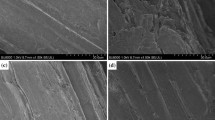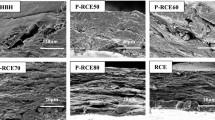Abstract
Sustainable EHL/PHBH biocomposites were prepared by the addition of enzymatic hydrolyzed lignin (EHL) into poly (3-hydroxybutyrate-co-3-hydroxyhexanoate) (PHBH) via solution casting technique. The research comprehensively evaluated the effects of EHL contents on the morphological, thermostability, barrier and anti-ultraviolet properties of EHL/PHBH biocomposites. SEM and FT-IR analysis showed that the EHL filler had good dispersibility in PHBH matrix and the good interface binding was observed in biocomposites. Compared with neat PHBH, the tensile strength and Young's modulus of biocomposites with 3 ~ 5 wt% EHL increased by 46.1% and 130.4%, respectively, and the maximum degradation temperature (Tmax) increased by 50 °C. More notably, a 30.2% and 52.3% reduction of the moisture and oxygen permeability, which were much higher than conventional plastics. It was also found that the biocomposites exhibited excellent UV resistance, almost completely shielding UV-A (320–400 nm) and UV-B (280–320 nm), and good antioxidant activity with 76.6% DPPH scavenging rate. The above, EHL/PHBH were demonstrated a promising biocomposites for anti-oxidation, UV-blocking, oxygen barrier and moisture-proof packaging materials.











Similar content being viewed by others
Data Availability
The publication related datasets are available from the corresponding author on reasonable request.
References
Narancic T, Cerrone F, Beagan N, O’connor KE (2020) Recent advances in bioplastics: application and biodegradation. Polymers 12:920. https://doi.org/10.3390/polym12040920
Tsujimoto T, Hosoda N, Uyama H (2016) Fabrication of porous poly(3-hydroxybutyrate-co-3hydroxyhexanoate) monoliths via thermally induced phase separation. Polymers 8:66. https://doi.org/10.3390/polym8030066
Yan X, Li DN, Ma XJ, Li JN (2021) Bioconversion of renewable lignocellulosic biomass into multicomponent substrate via pressurized hot water pretreatment for bioplastic polyhydroxyalkanoate accumulation. Bioresource Technol 339:125667. https://doi.org/10.1016/j.biortech.2021.125667
Meereboer KW, Misra M, Mohanty AK (2020) Review of recent advances in the biodegradability of polyhydroxyalkanoate (PHA) bioplastics and their composites. Green Chem 22:5519–5558. https://doi.org/10.1039/d0gc01647k
Li JN, Li DN, Su YH, Yan X, Wang F, Yu LL, Ma XJ (2022) Efficient and economical production of polyhydroxyalkanoate from sustainable rubber wood hydrolysate and xylose as co-substrate by mixed microbial cultures. Bioresource Technol 355:127238. https://doi.org/10.1016/j.biortech.2022.127238
Arifin W, Kuboki T (2018) Effects of glass fibers on mechanical and thermal properties of poly(3-hydroxybutyrate-co-3-hydroxyhexanoate). Polym Compos 39:491–503. https://doi.org/10.1002/pc.23960
Qiu YJ, Ma XJ (2019) Crystallization, mechanical and UV protection properties of graphene oxide/poly(3-hydroxybutyrate-co-3-hydroxyhexanoate) biocomposites. J Mater Sci 54:14388–14399. https://doi.org/10.1007/s10853-019-03951-5
Sergey K, Maria G, Konstantin B, Aleksandr V (2021) Differences in the physicochemical properties of lignins in the heartwood and sapwood of Pinus sylvestris. J Wood Chem Technol 41:177–184. https://doi.org/10.1080/02773813.2021.1954951
Fernandes EG, Pietrini M, Chiellini E (2004) Bio-based polymeric composites comprising wood flour as filler. Biomacromol 5:1200–1204. https://doi.org/10.1021/bm034507o
Xiong SJ, Pang B, Zhou SJ, Li MK, Yang S (2020) Economically competitive biodegradable PBAT/lignin composites: effect of lignin methylation and compatibilizer. ACS Sustainable Chem Eng 8:5338–5346. https://doi.org/10.1021/acssuschemeng.0c00789
Vostrejs P, Adamcová D, Vaverková MD, Enev V, Kalina M (2020) Active biodegradable packaging films modified with grape seeds lignin. RSC Adv 10:29202–29213. https://doi.org/10.1039/d0ra04074f
Zhou WP, Chen FG, Zhang H, Wang J (2017) Preparation of a polyhydric aminated lignin and its use in the preparation of polyurethane film. J Wood Chem Technol 37:323–333. https://doi.org/10.1080/02773813.2017.1299185
Stephanie BH, Ulrike WT, Nathan L, Jorgen L (2017) Characteristic properties of organosolv lignin/ polylactide copolymers. J Wood Chem Technol 37:211–224. https://doi.org/10.1080/02773813.2016.1272124
Zhang Y, Zhou S, Fang X, Zhou X, Wang J, Bai F, Peng S (2019) Renewable and flexible uv-blocking film from poly(butylene succinate) and lignin. Eur Polym J 116:265–274. https://doi.org/10.1016/j.eurpolymj.2019.04.003
Guo J, Chen X, Wang J, He Y, Xie H (2019) The influence of compatibility on the structure and properties of PLA/Lignin biocomposites by chemical modification. Polymers 12:56. https://doi.org/10.3390/polym12010056
Huang JB, Guo Q, Zhu RN, Liu YY, Xu F (2021) Facile fabrication of transparent lignin sphere/PVA nanocomposite films with excellent UV-shielding and high strength performance. Inter J Bio Macromo 189:635–640. https://doi.org/10.1016/j.ijbiomac.2021.08.167
Wang H, Wang YY, Fu FB, Qian Y, Xiao YH (2020) Controlled preparation of lignin/titanium dioxide hybrid composite particleswith excellent UVaging resistance and its high value application. Inter J Bio Macromo 150:371–379. https://doi.org/10.1016/j.ijbiomac.2019.12.185
Lugoloobi I, Li X, Zhang YC, Mao ZP, Wang BJ (2020) Fabrication of lignin/poly(3-hydroxybutyrate) nanocomposites with enhanced properties via a Pickering emulsion approach. Inter J Bio Macromo 165:3078–3087. https://doi.org/10.1016/j.ijbiomac.2020.10.156
Zhang S, Xiao J, Wang G, Chen G (2020) Enzymatic hydrolysis of lignin by ligninolytic enzymes and analysis of the hydrolyzed lignin products. Bioresour Technol 304:122975. https://doi.org/10.1016/j.biortech.2020.122975
Sheng Y, Lam SS, Wu Y, Ge S, Wu J (2021) Enzymatic conversion of pretreated lignocellulosic biomass: A review on influence of structural changes of lignin. Bioresour Technol 324:124631. https://doi.org/10.1016/j.biortech.2020.124631
Dong J, Zhou W, Su Y, Ma X (2020) Enhanced mechanical, thermal, and barrier properties of poly (3-hydroxybutyrate-co-3-hydroxyhexanoate)/montmorillonite nanocomposites using silane coupling agent. Polym compos 41:4538–4549. https://doi.org/10.1002/pc.25731
Vandewijngaarden J, Murariu M, Dubois P, Carleer R, Yperman J (2014) Gas permeability properties of poly(3-hydroxybutyrate-co-3hydroxyhexanoate). J Polym Environ 22:501–507. https://doi.org/10.1007/s10924-014-0688-1
Gulcin İ (2020) Antioxidants and antioxidant methods: an updated overview. Arch of Toxicol 94:651–715. https://doi.org/10.1007/s00204-020-02689-3
Jiang B, Zhang Y, Zhao H, Guo T, Wu W (2019) Structure-antioxidant activity relationship of active oxygen catalytic lignin and lignin-carbohydrate complex. Int J Biol Macromol 139:21–29. https://doi.org/10.1016/j.ijbiomac.2019.07.134
An L, Wang G, Jia H, Liu C, Sui W (2017) Fractionation of enzymatic hydrolysis lignin by sequential extraction for enhancing antioxidant performance. Int J Biol Macromol 99:674–681. https://doi.org/10.1016/j.ijbiomac.2017.03.015
Spiridon I, Tanase CE (2018) Design, characterization and preliminary biological evaluation of new lignin-PLA biocomposites. Int J Biol Macromol 114:855–863. https://doi.org/10.1016/j.ijbiomac.2018.03.140
Kumar A, Tumu VR, Chowdhury SR, SVS RR (2019) A green physical approach to compatibilize a bio-based poly (lactic acid)/lignin blend for better mechanical, thermal and degradation properties. Int J Biol Macromol 121:588–600. https://doi.org/10.1016/j.ijbiomac.2018.10.057
Rahman MA, Santis DD, Spagnoli G, Ramorino G, Penco M (2013) Biocomposites based on lignin and plasticized poly(L-lactic acid). J Appl Poly Sci 129:202–214. https://doi.org/10.1002/app.38705
Ikai A, Afrin R, Saito M, Watanabe-Nakayama T (2018) Atomic force microscope as a nano- and micrometer scale biological manipulator: A short review. Semin Cell Dev Biol 73:132–144. https://doi.org/10.1016/j.semcdb.2017.07.031
Chen R, Abdelwahab MA, Misra M, Mohanty AK (2014) Biobased ternary blends of lignin, poly(Lactic Acid), and poly(Butylene Adipate-co-Terephthalate): the effect of lignin heterogeneity on blend morphology and compatibility. J Polym Environ 22:439–448. https://doi.org/10.1007/s10924-014-0704-5
Mousavioun P, Doherty WOS, George G (2010) Thermal stability and miscibility of poly(hydroxybutyrate) and soda lignin blends. Ind Crops Prod 32:656–661. https://doi.org/10.1016/j.indcrop.2010.08.001
Puglia D, Fortunati E, D’amico DA, Manfredi LB, Cyras VP (2014) Influence of organically modified clays on the properties and disintegrability in compost of solution cast poly(3-hydroxybutyrate) films. Polym Degrad Stabil 99:127–135. https://doi.org/10.1016/j.polymdegradstab.2013.11.013
Luo S, Cao J, Mcdonald AG (2017) Esterification of industrial lignin and its effect on the resulting poly(3-hydroxybutyrate-co-3-hydroxyvalerate) or polypropylene blends. Ind Crops Prod 97:281–291. https://doi.org/10.1016/j.indcrop.2016.12.024
Zhou J, Ma XJ, Li JN, Zhu LZ (2018) Preparation and characterization of a bionanocomposite from poly (3-hydroxybutyrate-co-3-hydroxyhexanoate) and cellulose nanocrystals. Cellulose 26:979–990. https://doi.org/10.1007/s10570-018-2136-1
Morandim-Giannetti AA, Agnelli JAM, Lanças BZ, Magnabosco R, Casarin SA (2012) Lignin as additive in polypropylene/coir composites: thermal, mechanical and morphological properties. Carbohydr Polym 87:2563–2568. https://doi.org/10.1016/j.carbpol.2011.11.041
Wu CQ, Zhang XZ, Wang XH, Gao QW, Li XN (2019) Surface modification of cellulose nanocrystal using succinic anhydride and its effects on poly(butylene succinate) based composites. Cellulose 26:3167–3181. https://doi.org/10.1007/s10570-019-02292-5
Tang L, Qiu ZB (2016) Crystallization behavior and mechanical properties of biodegradable poly(L-lactide)/trisilanolisobutyl-polyhedral oligomeric silsesquioxanes nanocomposite. J Nanosci Nanotechno 16:10015–10020. https://doi.org/10.1166/jnn.2016.12371
Kovalcik A, Machovsky M, Kozakova Z, Koller M (2015) Designing packaging materials with viscoelastic and gas barrier properties by optimized processing of poly(3-hydroxybutyrate-co-3-hydroxyvalerate) with lignin. React Funct Polym 94:25–34. https://doi.org/10.1016/j.reactfunctpolym.2015.07.001
Li X, Hegyesi N, Zhang Y, Mao Z, Feng X (2019) Poly(lactic acid)/lignin blends prepared with the Pickering emulsion template method. Eur Polym J 110:378–384. https://doi.org/10.1016/j.eurpolymj.2018.12.001
Yang WJ, Weng YX, Debora P, Qi GC, Dong WD (2020) Poly(lactic acid)/lignin films with enhanced toughness and anti-oxidation performance for active food packaging. Int J Biol Macromol 144:102–110. https://doi.org/10.1016/j.ijbiomac.2019.12.085
Evie LP, Uttam CP, Thi NT, Giulia S, Luca C (2019) Sustainable active food packaging from poly(lactic acid) and cocoa bean shells. ACS Appl Mater Inter 11:31317–31327. https://doi.org/10.1021/acsami.9b09755
Wu Y, Qian Y, Zhang A, Lou H, Yang D (2020) Light color dihydroxybenzophenone grafted lignin with high UVA/ UVB absorbance ratio for efficient and safe natural sunscreen. Ind Eng Chem Res 59:17057–17068. https://doi.org/10.1021/acs.iecr.9b06970
Zhou YJ, Qian Y, Wang JY, Qiu XQ, Zeng HB (2020) Bioinspired lignin-polydopamine nanocapsules with strong bioadhesion for long-acting and high-performance natural sunscreens. Biomacromol 21:3231–3241. https://doi.org/10.1021/acs.biomac.0c00696
Monirsadat M, Mohammad RA, Leila K (2020) Antioxidant, antiradical, and antimicrobial activities of polysaccharides obtained by microwave-assisted extraction method: A review. Carbohydr Polym 229:115421. https://doi.org/10.1016/j.carbpol.2019.115421
Juan O, Antonio C, Elena OM, Antonio G, Alfonso AA (2021) Antimicrobial and antioxidant activities of flavonoids isolated from wood of sweet cherry tree (Prunus avium L.). J Wood Chem Technol 41:104–117. https://doi.org/10.1080/02773813.2021.1910712
Acknowledgements
This work was financially supported by Natural Science Foundation of Fujian Province (2022J01981) and Natural Science Foundation of Tianjin City (18JCYBJC90100).
Author information
Authors and Affiliations
Corresponding author
Ethics declarations
Conflict of Interest
The authors have no conflicts of interest to declare that are relevant to the content of the article.
Additional information
Publisher's Note
Springer Nature remains neutral with regard to jurisdictional claims in published maps and institutional affiliations.
Supplementary Information
Below is the link to the electronic supplementary material.
Rights and permissions
Springer Nature or its licensor (e.g. a society or other partner) holds exclusive rights to this article under a publishing agreement with the author(s) or other rightsholder(s); author self-archiving of the accepted manuscript version of this article is solely governed by the terms of such publishing agreement and applicable law.
About this article
Cite this article
Li, X., Jiang, T., Dong, J. et al. Fabrication of high-performance lignin/PHBH biocomposites with excellent thermal, barrier and UV-shielding properties. J Polym Res 29, 517 (2022). https://doi.org/10.1007/s10965-022-03378-8
Received:
Accepted:
Published:
DOI: https://doi.org/10.1007/s10965-022-03378-8




